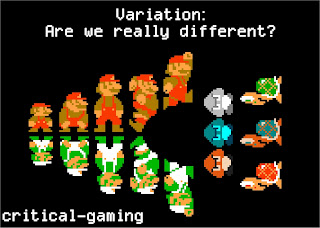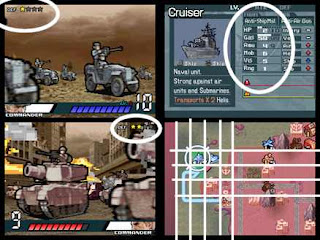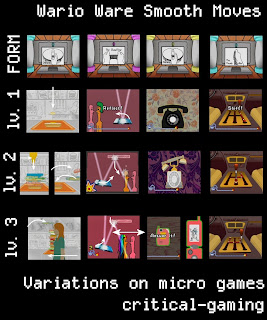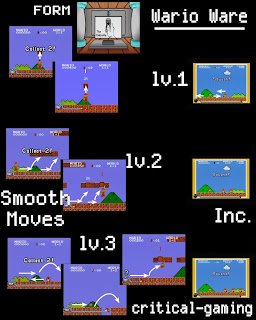Mario Melodies: Variation part.1
 Friday, June 20, 2008 at 11:29PM
Friday, June 20, 2008 at 11:29PM Repetition sits at the heart of music and videogames. Gamers naturally fall into sync with small repeated moments of gameplay in the same way that people sync with musical choruses, refrains, and melodies. But as a song moves forward, familiar melodies come and go only to return again slightly different. As a casual observer of music, it's hard to understand just how important repetition and changes to the repetitions are. Likewise, a game is just a series of repeated mechanics. Understanding how a game repeats and varies the use of its mechanics is the key to understanding the larger patterns and movements of a game. This is the essence of variation: how a game's elements influence the use of game mechanics over increasingly larger segments of the game.

There are many angles to approach videogame variation from. I've broken the gamut of variable game elements into six simple categories.
- player: character(s), cursor, avatar, HUD
- level: non aggressive interactive (physical) pieces
- enemy: hostile/aggressive forces
- audio: sound effects, music
- visual: non-interactive on screen elements
- rumble: force feedback
Now that the elements have been identified, there is one last concept that needs to be covered before we can begin our investigation of variation: what constitutes a change. At first, the answer may seem obvious. Most would settle with something along the lines of ... any difference, even a slight difference, from one case to another constitutes a change. While this definition works, it isn't practice for our purposes. We have to be a bit more discerning than that. Here's why.
If I moved all the Goombas in Super Mario Bros. one pixel to the left, would that change the gameplay in a significant way? Better yet, if I create new battle animations for Advance Wars, will that change any of the strategies, especially for the player who plays with animations off? In both cases, the alterations aren't enough to change the gameplay in any significant way.
The minimum difference is the smallest degree of change needed for a change to be significant for a particular mechanic. This value will vary with each game and each mechanic. Finding the minimum difference will help quantify a mechanic for the purposes of analysis. In other words, it's necessary to outline and define the smallest unit of significant change to give structure to the rest of one's investigation. The minimum difference isn't an objective figure, but rather it's a way to keep the researcher and the reader on the same page. Because games are highly structured systems, chances are, there already exists units of measuring the game's mechanics.
The Advance Wars series is quantified by the turn and the square. Movement, vision range, and attackable targets are all determined by a specific numbers of squares. Factors like ammo, fuel, incoming funds, and moves per unit are quantified and regulated by each turn that pass between the players. Additionally, offensive and defensive bonuses are measured in stars. So, a change to Advance Wars would only be significant if it added or subtracted a square, turn, or a star from a unit.

After identifying which elements you want to focus on and defining the base unit of variation using the minimum difference, we can start working with the game elements. There are two main ways of analyzing variation in a video game. Strict and open variation. Strict variation examines the exact way the game "levels" are arranged or grouped. Open variation is a bit more complicated because it doesn't look at examples from the game, rather it focuses on arrangements and groupings that the researcher creates. Such an approach looks at possible scenarios than existing ones. Both of these methods share the same rules and procedures, so I'll start with strict variation because it's easier to explain, show, and relate to.
All games can be broken down into sub-sections or sections. Whether a game is broken down by rooms, loading sections, cut scenes, stages, levels, rounds, or turns, if a game has a mechanic that is repeated, then it can be divided into sections. When a section contains an individual gameplay idea that isn't significantly and directly related to another section, then that section is considered a distinct section. When some refer to moments of a game as set pieces, they are essentially recognizing that the bigger game experience is composes of smaller individual moments of gameplay. Set piece is defined as "a scene, action, or the like, having a conventional form and functioning as part of the structure of a work of art, literature, etc." According to the music-game analogy that was outlined in the introduction of this series, distinct sections/set pieces are analogous to the musical motif.
Comparing similar distinct sections based on the mechanics used in each section is the easiest way to understand variation. Gamers do this automatically. Even if an area in a game looks and sounds different, gamers are the quickest to recognize if the gameplay is exactly the same as a previous area they've played. I often find myself saying "oh, this is just like the other battle/part/level/videogame."
For similar distinct sections, there are only 3 possible trends and 2 methods of variation. When similar distinct sections are arranged in the order that they appear in the game (to a reasonable degree) the change between the sections can either be diminishing, static, or refining. A diminishing trend is one where game elements are either added or subtracted that reduce the amount of consequences and allow for mechanics to be executed less precisely. A static trend is where there is no change between sections, or when the changes are inconsequential because they fall short of meeting the minimum requirement for the quantified mechanic. And finally, the refining trend is one that increases consequences that force the use of mechanics in a more precise manner by adding or subtracting game elements.
Adding or subtracting game elements to create diminishing/refining trends can be done in two ways. The first method is linear variation: adding or subtracting a single game element or fixed group of elements in a specific arrangement. The second method is the conceptual/elemental variation: adding or subtracting a different elements than what was modified in the previous step.
If you're feeling lost at this point, don't worry. It's all easier than it sounds. It really helps to read through the examples. I believe I have found the game series that provides the best examples for learning about Variation: the Wario Ware series. The Wario Ware games are composed of hundreds of quick fire microgames that generally last no longer than 10 seconds each. At the beginning of each microgame a short message is displayed on the screen that clues the player into the primary mechanic and goal of the microgame. The microgames are simple at first, but the difficulty quickly ramps up. Besides increasing the speed, which decreases the amount of time the player has to understand and complete each microgame, each microgame is designed with 3 distinct levels of difficulty. Each difficulty level is a distinct section that's ready for analysis. With hundreds of games to draw from, clearly stated primary mechanics, distinct sections already provided, I can't think of a better game to illustrate variation.
From Left to Right...
- Elements: visual = food items, customers
- Primary mechanic: "Take when ready!" = pick up the Wiimote when the burger is complete, which is signified by a sesame seed bun on top. individual, intuitive, direct.
- Minimum difference: none. It's either on or off.
- Trend: static
- Method: conceptual variation = vertically falling ingredients, sideways flying ingredients, condiments, customers walking in front
- In this microgame, the same strategy works for all three levels: take the burger when you see the bun on top. The first level tests the players ability to recognize the different burger parts as they are assembled. The second level throws in "distractors" to try and make the player pick up the Wiimote prematurely, the most devious of which is the sesame bun that flies over the stack but doesn't land on top. The third level adds another type of distractor. Customers rudely walk in front of the counter obscuring the players view of the burger assembly process.
- Because the input for this game is one way or the other, and the elements involved are visual (non interactive), the variation trend can't be refining.
- Elements: player = blue reflecting mirror, level = white mirror, light beam, colored people
- Primary mechanic: "Reflect!" The angle of the Wiimote determines the angle of the blue mirror. individual, intuitive, direct, and dynamic.
- Minimum difference: 5 degrees of difference based on the possible angles to head size ratio. I reached this measure more or less arbitrarily.
- Trend: refining.
- Method: linear then conceptual variation = bouncing a light beam x1, bouncing a light beam x2, hitting a moving target.
- The first level tests the player's ability to reflect a beam of light and aim at a still target. The second level tests the player's ability to reflect a beam twice and hit a target. The final level adds on to the first by introducing a moving target. Also, the beam of light enters the field at a different angle to truly test if player can measure out the angles instead of simply memorizing the set up.
- Elements: visuals = various phones, sound = ringing, rumble = ringing
- Primary mechanic: "Answer it!" Pick up the Wiimote when the phone rings. Hit the A "talk" button for cell phones. individual, intuitive, direct.
- Minimum difference: none.
- Trend: static then refining.
- Method: linear then conceptual variation = wait for the phone to ring and then pick it up is the strategy that works for levels 1 and 2. However, on level 3, the cell phone requires the "talk" button to be pressed which further defines the mechanic "answer it" beyond simply picking up the receiver. The form of the cell phone was well implemented.
- Elements: level = shift stick
- Primary mechanic: "Shift!" move the Wiimote in the directions indicated as if it were an actual shift stick.
- Minimum difference: a single shift.
- Trend: refining.
- Method: linear = Level 1 has 2 shifts, and each subsequent level simply adds an additional shift.
If you want some practice, try analyzing these last two Wario Ware microgames on your own. The left column is from Wario Ware Smooth Moves, and the right column is from Wario Ware Inc. Mega Party Games$!. Send your answers my way and I'll be sure to give feedback.
In Variation part.2 we'll look at open variation and a summary technique called translation. Change is a good thing.



